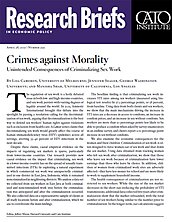The regulation of sex work is a hotly debated issue in both low- and high-income countries, and sex work persists with varying degrees of legality around the world. In 2015, Amnesty International brought this debate into the spotlight by passing a resolution calling for the decriminalization of sex work, arguing that decriminalization is the best way to defend sex workers’ human rights against violations such as exclusion from health care. A Lancet series claims that decriminalizing sex work would greatly affect the course of human immunodeficiency virus (HIV) epidemics across all settings, averting 33–46 percent of HIV infections in the next decade.
Despite these claims, causal empirical evidence on the impacts of regulating sex markets is sparse, particularly from lower-income countries. Our research provides new causal evidence on the impact that criminalizing sex work in a lower-income country has on the spread of sexually transmitted infections (STIs) by exploiting a natural experiment in which commercial sex work was unexpectedly criminalized in one district in East Java, Indonesia, while it remained noncriminalized in neighboring districts. We analyze a data set we collected from sex workers in East Java at both criminalized and noncriminalized work sites before the criminalization was anticipated and after the criminalization occurred. We also collected data on a representative sample of clients at all study locations before and after criminalization, which we use to corroborate the main findings.
The headline finding is that criminalizing sex work increases STI rates among sex workers (measured using biological test results) by 27.3 percentage points, or 58 percent, from baseline. Using data from both clients and sex workers, we show that the main mechanisms driving the increase in STI rates are a decrease in access to condoms, an increase in condom prices, and an increase in sex without condoms. Sex workers are more than 50 percentage points less likely to be able to produce a condom when asked by survey enumerators in an endline survey, and clients report a 61 percentage point increase in sex without condoms.
We also examine the economic consequences for the women and their children. Criminalization of sex work is often designed to force women out of sex work and shut down the sex market. Using data obtained from tracking women who left sex work after criminalization, we show that those who leave sex work because of criminalization have lower earnings than those who leave by choice. In addition, children of women from criminalized work sites are adversely affected—they have less money for school and are more likely to work to supplement household income.
The health consequences of criminalization are not restricted to sex workers. While the size of the sex market decreases in the short run (reducing the probability of STI transmission), additional data collected five years after criminalization show that the market rebounded, with the total number of sex workers being similar to the number prior to criminalization. In the longer-term, our calculations suggest that criminalization results in substantial increases in the probability of STI transmission to the general population. Depending on the counterfactual, the transmission probability under criminalization five years later ranges between 22 and 59.3 percent higher for males and between 13.6 and 48.3 percent higher for non-sex-worker females compared with the transmission probability if sex work had not been criminalized in this district. Therefore, the long-run public health impacts of criminalization, particularly in a country like Indonesia that already has high rates of HIV and a population with limited access to testing and medication, are potentially alarming.
Understanding the impacts of criminalization (or decriminalization) on sex markets in lower-income countries is arguably even more important than in higher-income countries. First, sex work has played an important role in the spread of HIV in lower-income countries. In Indonesia, HIV prevalence among female sex workers is estimated to be 9 percent—38 times higher among sex workers than the general female population. In addition, there is substantial variation across the country, with the highest HIV prevalence being 56 percent among female sex workers in the central highlands of Papua. Second, relatively more women in lower-income countries participate in sex markets. Female sex worker prevalence (defined as the proportion of female sex workers in the adult female population aged 15–49 years) ranges 0.7–4.3 percent in sub-Saharan Africa, 0.2–2.6 percent in Asia, and 0.2–7.4 percent in Latin America, compared with only 0.1–1.4 percent in Western Europe. Lastly, coupling these elements with lower incomes, less education, and, hence, less health knowledge alongside a less developed health care system means that changes in sex worker HIV and STI rates due to market changes may have larger public health implications in lower-income countries. It is thus critical to understand the magnitudes of the impacts of such policies when applied in these settings.
NOTE:
This research brief is based on Lisa Cameron, Jennifer Seager, and Manisha Shah, “Crimes against Morality: Unintended Consequences of Criminalizing Sex Work,” Quarterly Journal of Economics 136, no. 1 (February 2021): 427–69, https://doi.org/10.1093/qje/qjaa032.

This work is licensed under a Creative Commons Attribution-NonCommercial-ShareAlike 4.0 International License.
